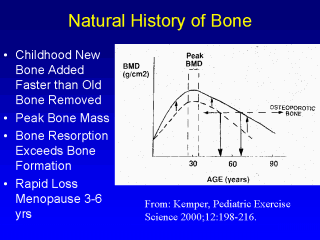 |
Bone mass
reflects a balance between bone formation and bone loss. The balance is tipped in favor of
bone mass accretion during childhood and adolescence. Like overall growth in height and
weight, bone mass increases substantially during the first few years of life, then slows
down until the onset of puberty when another marked increase occurs, ending at about age
16 to 18 years. The patterns and amount of bone mass for girls and boys are generally
similar during childhood; however, puberty-related growth generally occurs at a younger
chronological age for girls than for boys. During puberty, bone mass increases faster in
boys than in girls and males eventually achieve a higher peak bone mass than females. For
both boys and girls the greatest change in bone mass per year occurs one-half year to one
year after their greatest change in height per year. During the pubertal growth spurt as
much as 60% of peak bone mass is achieved. Of great importance is the recognition that,
for both sexes, as much bone is accrued during these adolescent years as most individuals
will lose during all of adult life (5). Exactly when
peak bone mass is achieved is still unclear, but most of the process is completed by the
late teens for females and early twenties for males, although small increases in lumbar
spine and other skeletal regions continue until the late twenties or early thirties. For
both men and women, there is then a stable period through early and middle adulthood until
about 50 years of age when bone mass losses can be detected. This loss is accelerated in
women during the three to six years immediately after menopause. Slower but continual bone
mass loss and internal supporting structural losses continue with age for both women and
men. Eventually, bones can become so weak that they readily fracture.
5. Kemper HCG. Skeletal development during childhood and
adolescence and the effects of physical activity. Pediatric Exerc Sci 2000;12:198-216. |
